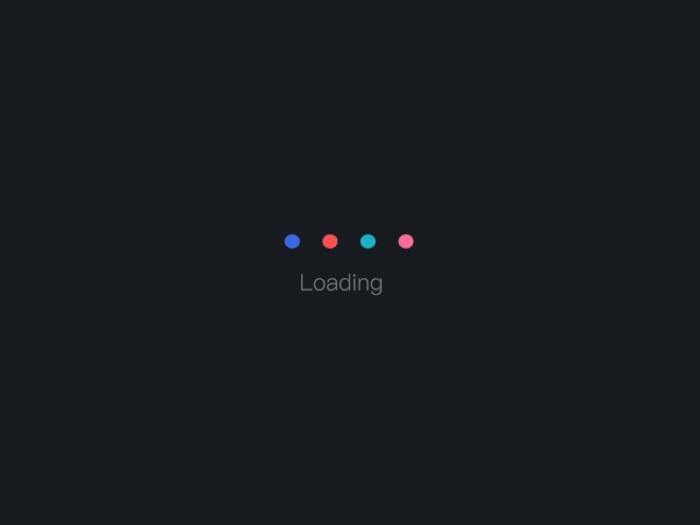用Axios Element實作全域的請求loading的方法
本篇文章主要介紹了用Axios Element實現全域的請求loading的方法,現在分享給大家,也給大家做個參考。
背景
業務需求是這樣子的,每當發送請求到後端時就觸發一個全螢幕的 loading,多個請求合併為一次 loading。
現在專案中用的是 vue 、axios、element等,所以文章主要是說如果使用 axios 和 element 來實現這個功能。
效果如下:

分析
首先,請求開始的時候開始loading, 然後在請求返回後結束loading。重點就是要攔截請求和回應。
然後,要解決多個請求合併為一次 loading。
最後,呼叫element 的 loading 元件即可。
攔截請求和回應
axios 的基本使用方法不贅述。筆者在專案中使用 axios 是以建立實例的方式。
// 创建axios实例
const $ = axios.create({
baseURL: `${URL_PREFIX}`,
timeout: 15000
})然後再封裝post 請求(以post 為例)
export default {
post: (url, data, config = { showLoading: true }) => $.post(url, data, config)
}// 请求拦截器
$.interceptors.request.use((config) => {
showFullScreenLoading()
return config
}, (error) => {
return Promise.reject(error)
})
// 响应拦截器
$.interceptors.response.use((response) => {
tryHideFullScreenLoading()
return response
}, (error) => {
return Promise.reject(error)
})let needLoadingRequestCount = 0
export function showFullScreenLoading() {
if (needLoadingRequestCount === 0) {
startLoading()
}
needLoadingRequestCount++
}
export function tryHideFullScreenLoading() {
if (needLoadingRequestCount <= 0) return
needLoadingRequestCount--
if (needLoadingRequestCount === 0) {
endLoading()
}
}import { Loading } from 'element-ui'
let loading
function startLoading() {
loading = Loading.service({
lock: true,
text: '加载中……',
background: 'rgba(0, 0, 0, 0.7)'
})
}
function endLoading() {
loading.close()
}功能增強
實際上,現在的功能還差一點。如果某個請求不需要 loading 呢,那麼發送請求的時候加個 showLoading: false的參數就好了。在請求攔截和回應攔截時判斷下該請求是否需要loading,需要 loading 再去呼叫showFullScreenLoading()方法即可。 在封裝 post 請求時,已經在第三個參數加了 config 物件。 config 包含了 showloading。然後在攔截器中分別處理。// 请求拦截器
$.interceptors.request.use((config) => {
if (config.showLoading) {
showFullScreenLoading()
}
return config
})
// 响应拦截器
$.interceptors.response.use((response) => {
if (response.config.showLoading) {
tryHideFullScreenLoading()
}
return response
})############################ #######
以上是用Axios Element實作全域的請求loading的方法的詳細內容。更多資訊請關注PHP中文網其他相關文章!

熱AI工具

Undresser.AI Undress
人工智慧驅動的應用程序,用於創建逼真的裸體照片

AI Clothes Remover
用於從照片中去除衣服的線上人工智慧工具。

Undress AI Tool
免費脫衣圖片

Clothoff.io
AI脫衣器

Video Face Swap
使用我們完全免費的人工智慧換臉工具,輕鬆在任何影片中換臉!

熱門文章

熱工具

記事本++7.3.1
好用且免費的程式碼編輯器

SublimeText3漢化版
中文版,非常好用

禪工作室 13.0.1
強大的PHP整合開發環境

Dreamweaver CS6
視覺化網頁開發工具

SublimeText3 Mac版
神級程式碼編輯軟體(SublimeText3)
 在Vue應用程式中使用axios時出現「Uncaught (in promise) Error: Request failed with status code 500」怎麼辦?
Jun 24, 2023 pm 05:33 PM
在Vue應用程式中使用axios時出現「Uncaught (in promise) Error: Request failed with status code 500」怎麼辦?
Jun 24, 2023 pm 05:33 PM
在Vue應用程式中使用axios是十分常見的,axios是一種基於Promise的HTTP客戶端,可以用於瀏覽器和Node.js。在開發過程中,有時會出現「Uncaught(inpromise)Error:Requestfailedwithstatuscode500」的錯誤提示,對於開發者來說,這個錯誤提示可能有些難以理解和解決。本文將會探討這
 Vue中資料請求的選擇:Axios or Fetch?
Jul 17, 2023 pm 06:30 PM
Vue中資料請求的選擇:Axios or Fetch?
Jul 17, 2023 pm 06:30 PM
Vue中資料請求的選擇:AxiosorFetch?在Vue開發中,處理資料請求是一個非常常見的任務。而選擇使用哪種工具來進行資料請求,則是需要考慮的問題。在Vue中,最常見的兩種工具是Axios和Fetch。本文將會比較這兩種工具的優缺點,並給出一些範例程式碼來幫助你做出選擇。 Axios是一個基於Promise的HTTP客戶端,可以在瀏覽器和Node.
 element.style怎麼修改
Nov 24, 2023 am 11:15 AM
element.style怎麼修改
Nov 24, 2023 am 11:15 AM
element.style修改元素的方法:1、修改元素的背景顏色;2、修改元素的字體大小;3、修改元素的邊框樣式;4、修改元素的字體樣式;5、修改元素的水平對齊方式。詳細介紹:1、修改元素的背景顏色,其語法為「document.getElementById("myElement").style.backgroundColor = "red";」;2、修改元素的字體大小等等。
 在Vue應用程式中使用axios時出現「TypeError: Failed to fetch」怎麼辦?
Jun 24, 2023 pm 11:03 PM
在Vue應用程式中使用axios時出現「TypeError: Failed to fetch」怎麼辦?
Jun 24, 2023 pm 11:03 PM
最近,在使用Vue應用程式開發過程中,我遇到了一個常見的問題:「TypeError:Failedtofetch」錯誤提示。這個問題出現在使用axios進行HTTP請求時,後端伺服器沒有正確回應請求時發生。這種錯誤提示通常表示請求無法到達伺服器,可能是由於網路原因或伺服器未回應造成的。出現這個錯誤提示後,我們該怎麼辦呢?以下是一些解決方法:檢查網路連接由於
 在Vue應用程式中使用axios時出現「Error: Network Error」怎麼解決?
Jun 25, 2023 am 08:27 AM
在Vue應用程式中使用axios時出現「Error: Network Error」怎麼解決?
Jun 25, 2023 am 08:27 AM
在Vue應用程式中使用axios時出現「Error:NetworkError」怎麼解決?在Vue應用程式的開發中,我們常常會使用到axios進行API的請求或資料的獲取,但是有時我們會遇到axios請求出現「Error:NetworkError」的情況,這時我們該怎麼辦呢?首先,需要了解「Error:NetworkError」是什麼意思,它通常表示網路連
 高效利用Vue和Axios實現前端資料的批次處理
Jul 17, 2023 pm 10:43 PM
高效利用Vue和Axios實現前端資料的批次處理
Jul 17, 2023 pm 10:43 PM
高效利用Vue和Axios實現前端資料的批次處理在前端開發中,資料的處理是一個常見的任務。當我們需要處理大量資料時,如果沒有有效的方法,處理資料將會變得十分繁瑣和低效。 Vue是一種優秀的前端框架,而Axios是一個流行的網路請求庫,它們可以協同工作來實現前端資料的批次處理。本文將詳細介紹如何有效利用Vue和Axios來進行資料的批次處理,並提供相關的程式碼範例
 怎麼使用vue3+ts+axios+pinia實現無感刷新
May 25, 2023 pm 03:37 PM
怎麼使用vue3+ts+axios+pinia實現無感刷新
May 25, 2023 pm 03:37 PM
vue3+ts+axios+pinia實作無感刷新1.先在專案中下載aiXos和pinianpmipinia--savenpminstallaxios--save2.封裝axios請求-----下載js-cookienpmiJS-cookie-s//引入aixosimporttype{AxiosRequestConfigig ,AxiosResponse}from"axios";importaxiosfrom'axios';import{ElMess
 在Vue應用程式中使用axios時出現「Error: timeout of xxxms exceeded」怎麼辦?
Jun 24, 2023 pm 03:27 PM
在Vue應用程式中使用axios時出現「Error: timeout of xxxms exceeded」怎麼辦?
Jun 24, 2023 pm 03:27 PM
在Vue應用程式中使用axios時出現「Error:timeoutofxxxmsexceeded」怎麼辦?隨著網路的快速發展,前端技術也不斷地更新迭代,Vue作為優秀的前端框架,近年來受到大家的歡迎。在Vue應用程式中,我們常常需要使用axios來進行網路請求,但是有時候會出現「Error:timeoutofxxxmsexceeded」的錯誤






